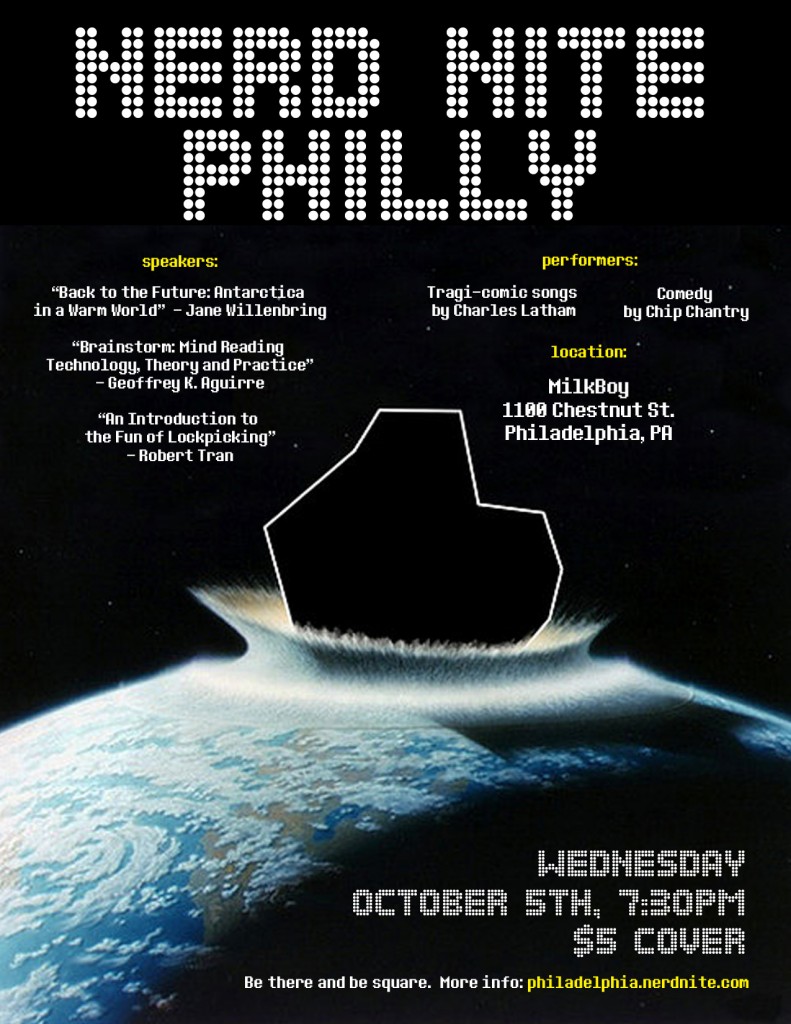Nerd Nite No. 7, October 5, 2011
Yo Nerds,
Mark your calendars for the return of Nerd Nite!
Wednesday, October 5, 2011
MilkBoy Philly, 1100 Chestnut St.
doors at 7:30, show at 8:00
5 dollar cover
Boy have we got a show in store for you:
“Back to the Future: Antarctica in a Warm World” by Jane Willenbring, Univ. of Pennsylvania
East Antarctica hosts the largest amount of ice on land on Earth. As such, it is particularly important to understand what happens to this ice when the Earth warms. Does it melt and contribute to sea level rise? Or, does the ice sheet expand due to an increased ability of warmer air to hold moisture? Until recently, the Earth Science community has had limited ability to measure rates of surface processes that occur over long time periods, such as recording the very slow glacier margin movements and other imperceptibly slow rates of land surface change. In this talk, I will discuss a novel geochemical technique that uses cosmic radiation to date rocks at the Earth’s surface. This technique has revolutionized our understanding of how the East Antarctic Ice Sheet responded to times in the past that were even warmer than today and helps us to go Back to the Future.
Bio: Dr. Jane Willenbring is an Assistant Professor in the Department of Earth and Environmental Sciences at the University of Pennsylvania where she leads a research group that uses field work, isotope geochemistry and the changing composition of the Earth’s water and atmosphere to study the response of the landscape to the rise of mountains, sea level, ice sheets and civilizations. She is originally from North Dakota and so is well-suited to the cold temperatures like those near the South Pole in the ’summer’ time – but she still dislikes the cold.
***************************************************************
“Brainstorm: Mind reading technology, theory and practice” by Geoffrey K. Aguirre, Univ. of Pennsylvania
Using machines to “read out” the contents of sensory experience directly from the brain has been a staple of science fiction. Recently, functional magnetic resonance imaging (fMRI) has been used to reconstruct a ”movie” of visual perception for human participants. I’ll explain how this works, and what the prospects and limits are of mind reading technology.
Bio: Geoffrey Aguirre is a Neurologist and cognitive neuroscientist. His clinical and research work concerns the organization of the brain for mental operations, in particular the loss and recovery of visual ability. Using functional MRI, a non-invasive tool for measuring brain activity, he studies how neurons are normally arranged to represent and store the appearance of people, places, and things. He uses these techniques to understand as well how blindness changes the brain, and with collaborators at the University of Pennsylvania, how the brain adapts to the recovery of vision.
***************************************************************
“An Introduction to the Fun of Lockpicking” by Robert Tran, The Open Organization of Lockpickers
Everyone relies on their locks to keep things secure. From front doors to filing cabinets, they give us the sense of security that no one else can get inside without the proper key. However, in reality, most locks can be picked trivially without any evidence of exploitation. You will learn how and why lockpicking works as well as what manufacturers have done to protect against such shenanigans.
Bio: Robert Tran is a security professional by day, but some say he’s a super-secret agent by night. He’s been tinkering and taking apart technology since childhood, but hasn’t necessary figured out how to reassemble them. When Robert is not wrenching on his cars or motorcycles, he’s picking locks. Going by the handle “Dr. Tran”, he’s been an active member of TOOOL for 3 years and has taught at conferences including Shmoocon, CarolinaCon, NotaCon, Security BSides, QuahogCon, HOPE, & Defcon.
And featuring:
Tragi-comic songs by Charles Latham and Comedy by Chip Chantry.
